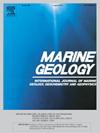Study on the response and recovery of beach sediments under the impact of Typhoon “Chaba” (no. 2203) and high-elevation aquaculture pond effluent discharge
IF 2.2
3区 地球科学
Q2 GEOSCIENCES, MULTIDISCIPLINARY
引用次数: 0
Abstract
Under the combined influences of climate change and human activities, coastal sediments dynamic and recovery mechanisms following extreme storm events have become central issues in coastal research and management. This study investigates beach sediment dynamics and recovery processes under the joint effects of Typhoon No. 2203 “Chaba” and high-elevation aquaculture pond (HEAP) effluent discharge. The key findings are as follows: Typhoon forcing conditions: During the event, wind direction shifted from ES to N and wind speed rose from 6.46 m/s to 14.43 m/s, superimposed on a 4.18 m storm surge. The mean wave period and significant wave height rose to 7.34 s and 1.38 m, respectively, while the shear-stress due to waves surged from 0.20 to 4.20 N/m2—far exceeding the threshold shear-stress of 0.60 N/m2. On the normal beach, typhoon events led to finer sediment deposition on the upper beach and coarser sediment on the lower beach. These changes rapidly returned to the pre-typhoon state within one week. On the impacted beach, typhoon events and aquaculture effluent significantly altered sediment distribution. Combined effects of effluent-driven morphology and hydrodynamics caused complex patterns and limited recovery. Effluent discharge, tidal action, and wave dynamics collectively establish a high-energy conduit system that extends the landward reach of tidal inundation and intensifies erosion at the beach berm and coastal dune front. This synergistic forcing underlies the rapid evolution of scour-trench and grain-size distributions during extreme events. Therefore, it is recommended to implement coordinated strategies in terms of drainage outlet placement, ecological protection measures, and management practices. These measures aim to promote harmony between aquaculture and the beach environment, ensuring sustainable ecological and economic development.
台风“查巴”对海滩沉积物的影响及恢复研究。2203)和高海拔养殖池塘污水排放
在气候变化和人类活动的共同影响下,极端风暴事件后海岸沉积物的动力和恢复机制已成为海岸研究和管理的核心问题。本文研究了2203号台风“察巴”和高海拔养殖池(HEAP)污水排放共同作用下的海滩沉积物动态和恢复过程。主要发现如下:台风强迫条件:事件期间,风向由东南向北转变,风速由6.46 m/s上升至14.43 m/s,叠加了4.18 m风暴潮;平均波周期和有效波高分别上升到7.34 s和1.38 m,波浪引起的剪切应力从0.20 N/m2上升到4.20 N/m2,远远超过阈值0.60 N/m2。在正常海滩上,台风事件导致上海滩沉积物沉积较细,下海滩沉积物较粗。这些变化在一周内迅速恢复到台风前的状态。在受影响的海滩上,台风事件和水产养殖废水显著改变了沉积物的分布。污水驱动的形态和流体动力学的共同作用导致了复杂的模式和有限的采收率。污水排放、潮汐作用和波浪动力学共同建立了一个高能管道系统,扩大了潮汐淹没向陆地的范围,加剧了海滩护堤和海岸沙丘前缘的侵蚀。这种协同强迫是极端事件期间冲沟和粒度分布快速演变的基础。因此,建议在排水口布置、生态保护措施和管理实践等方面实施协调策略。这些措施旨在促进水产养殖与海滩环境的和谐,确保生态和经济的可持续发展。
本文章由计算机程序翻译,如有差异,请以英文原文为准。
求助全文
约1分钟内获得全文
求助全文
来源期刊

Marine Geology
地学-地球科学综合
CiteScore
6.10
自引率
6.90%
发文量
175
审稿时长
21.9 weeks
期刊介绍:
Marine Geology is the premier international journal on marine geological processes in the broadest sense. We seek papers that are comprehensive, interdisciplinary and synthetic that will be lasting contributions to the field. Although most papers are based on regional studies, they must demonstrate new findings of international significance. We accept papers on subjects as diverse as seafloor hydrothermal systems, beach dynamics, early diagenesis, microbiological studies in sediments, palaeoclimate studies and geophysical studies of the seabed. We encourage papers that address emerging new fields, for example the influence of anthropogenic processes on coastal/marine geology and coastal/marine geoarchaeology. We insist that the papers are concerned with the marine realm and that they deal with geology: with rocks, sediments, and physical and chemical processes affecting them. Papers should address scientific hypotheses: highly descriptive data compilations or papers that deal only with marine management and risk assessment should be submitted to other journals. Papers on laboratory or modelling studies must demonstrate direct relevance to marine processes or deposits. The primary criteria for acceptance of papers is that the science is of high quality, novel, significant, and of broad international interest.
 求助内容:
求助内容: 应助结果提醒方式:
应助结果提醒方式:


